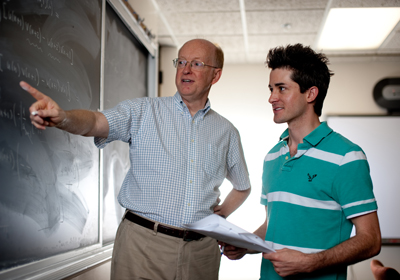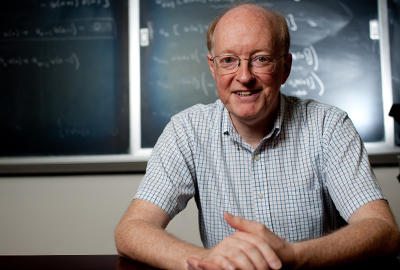“Doing math” is usually pictured as a solitary activity involving a chalkboard and harsh florescent lights. Yet that could not be further from the truth.
“Contrary to stereotype, mathematics is a very social activity,” said mathematics professor Peter Perry, who was recently awarded the prestigious College of Arts and Sciences Distinguished Professor Award for the 2010-2011 academic year. “It’s a lot more fun and works a lot better when you have other people to work with, talk things over with, bounce ideas off of and understand things.”
 This group process of “doing math” extends throughout all levels of mathematical instruction – from basic undergraduate calculus classes to upper-level graduate instruction – and Perry is actively involved at all levels from reading papers with his graduate students to his role as the director of MathExcel.
This group process of “doing math” extends throughout all levels of mathematical instruction – from basic undergraduate calculus classes to upper-level graduate instruction – and Perry is actively involved at all levels from reading papers with his graduate students to his role as the director of MathExcel.
MathExcel, which celebrates its 20th anniversary this year, was started in 1990 by mathematics professor Michael Freeman as a program to give freshman calculus students a solid set of group study skills that would serve them well both in their introductory level calculus classes as well as the rest of their tenure as UK students.
“It is targeted toward students who have the intellectual wherewithal to succeed in calculus but would benefit from help gaining the study skills needed to master calculus,” explained Perry.
MathExcel students meet in groups of 6-8 students three times a week and, under the supervision of a graduate student leader and two upper-classman peer-mentors, work through a series of equations together as a group. The results have been stunning.
“In the Fall 2009 semester, overall 69 percent of calculus students earned an A, B or C while 81 percent of MathExcel calculus students earned an A, B or C. Out of 666 calculus students, 81 withdrew overall. Only three out of 78 MathExcel students withdrew,” said Perry.
"Our students stick with it, get better grades and the reason why is they are getting more practice, they are getting more personal attention and we follow them more closely."
As a full professor with significant research achievements, one might expect someone of Perry’s seniority to only be teaching upper level graduate courses in mathematics. Yet during the 2009-2010 school year, Perry taught only one graduate level seminar and eight sections of basic level calculus.
 “It’s all mathematics. If you have a love of mathematics as I do and if you’re enthusiastic about the subject, teaching mathematics at any level is basically the same activity,” said Perry. “You want to communicate mathematical ideas and you want to get people enthusiastic about mathematics. In that sense it really doesn’t matter what level you’re teaching.”
“It’s all mathematics. If you have a love of mathematics as I do and if you’re enthusiastic about the subject, teaching mathematics at any level is basically the same activity,” said Perry. “You want to communicate mathematical ideas and you want to get people enthusiastic about mathematics. In that sense it really doesn’t matter what level you’re teaching.”
Perry goes on to point out another benefit of MathExcel: it equips its graduate students and peer-mentors with formative teaching experiences, building confidence in themselves as instructors while working one-on-one with students and igniting an enthusiasm for teaching.
This one-on-one mentorship of students is something Perry practices with his own graduate students. “The process of watching a graduate student’s understanding and facility with mathematics mature is really one of the most rewarding things that I do,” said Perry, who credits his own father, a professor of religion at the Northwestern University, with providing the example of his personal dedication to teaching and mentoring students.
Perry’s professed love of mathematics was fostered as a child growing up in the 1960s enthralled by science and space exploration. Later, when studying theoretical physics in college, Perry found himself “…drawn more and more toward mathematics as the language of science, as something which intellectually seemed very beautiful to me. The way that you could see connections between seemingly unrelated areas.”
As a researcher, Perry specializes in inverse problems that at their core concern one of the most basic mathematical concepts: a function. Does every output correspond to the same input? Or can there be more than one input that gives the same output?
While Perry’s research doesn’t directly translate to concrete applications like writing a computer program – “I’m a pure mathematician” – he work in areas of mathematics that provide the theoretical framework for a myriad of applications from CAT scans to seismology.
From teaching and mentoring students to research, Perry’s approach to the practice of mathematics is fundamentally group and community oriented, and infused with both discipline and enthusiasm. It is what “doing math” is all about.
by Rebekah Tilley
